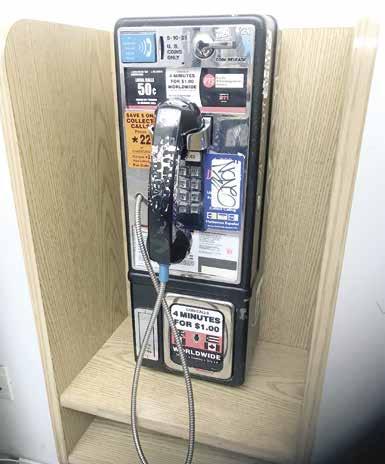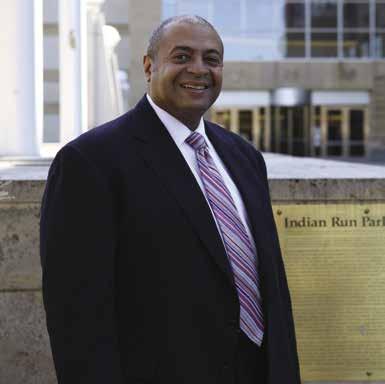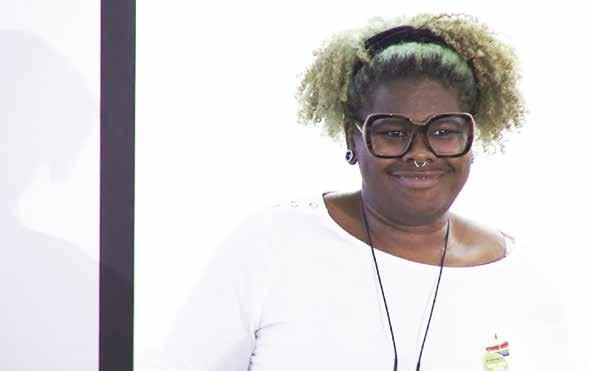
17 minute read
OpEd
EDITORIAL
Seven Mass Shootings in Seven Days – Haven’t We Had Enough?
In mid-February, we reported on D.C. Mayor Muriel Bowser’s decision to declare gun violence in the District as a public health crisis. She also announced her plan to assemble an emergency operations center to address the deadly surge in gun violence and appointed Linda Harllee Harper as D.C.’s first gun violence prevention director.
While we applauded the mayor’s decision, we questioned why it had taken her so long to act with the initiative’s first target being Anacostia given city officials admitting that it was common knowledge that 2 percent of all blocks in the city (in the above mentioned Southeast community) were the site of 41 percent of all gunshot-related crimes last year.
In fact, although overall violent crime declined in 2020, gun violence rose with 922 people shot – a 33 percent increase from 2019 and with 198 murders – a 19 percent increase. A closer look reveals that most murder victims in 2020 were Black (95 percent) with Black men accounting for 81 percent of all victims and Black women, 15 percent.
“This is a level of violence that we haven’t seen in more than a decade,” Bowser said. “And the homicide trends are disturbing . . . We know that we must act and we must act differently.”
Bowser’s commitment to taking immediate action and her recognition that a different strategy must be both devised and employed should now be heeded by the nation’s leaders in Congress.
After two massacres in less than a week in Boulder and Atlanta, many Americans remain in shock while the debate on gun control has once again dominated conversations from hidden culde-sacs to Capitol Hill. COVID-19 may have been in the headlines for the past year but mass shootings were still occurring and in large numbers. Ignorance is not always bliss!
Date provided by the Gun Violence Archive, a nonprofit group that catalogs gun violence in the U.S., reveals that 104 mass shootings have occurred in 29 states plus the District in 2021 so far with 120 people killed and more than 380 injured. (Gun Violence Archive defines a mass shooting as four or more people shot or killed in a single incident not including the shooter).
In 2021, we’ve continued where we left off in 2020 during which there were 611 mass shootings – the highest number since the Gun Violence Archive began tracking them in 2014.
President Biden, speaking to the nation on March 23 after the Colorado shooting, said, “I don’t need to wait one more minute, let alone an hour, to take common steps that will save lives in the future. I urge my colleagues in the House and Senate to act. We can ban assault weapons and high capacity magazines in this country once again. We got it done when I was in the Senate . . . we should do it again.”
In his illuminating study on America’s transformation from the right to arms in colonial America to today’s gun-control debate, “Armed in America,” historian and legal scholar Patrick J. Charles asserts that in today’s “golden age of gun rights,” gun rights have become both politicized and normalized.
But is it “normal” for a nation to witness seven mass shootings – in Boulder, Atlanta, Stockton (Calif.), Gresham (Oregon), Houston, Dallas and Philadelphia – in just seven days across the U.S.?
This is no longer a political issue for debate. As Bowser declared about the District, gun violence is now a public health crisis in America too. How many more lives must be lost until drastic changes are made? WI
A Long Way to Go to #51
I'm for D.C. statehood, but I don't want to get my hopes up. Seems like an uphill battle and a lot of questions that would need to be answered for the right votes to happen. I'm cautiously optimistic.
Bill Leonard Washington, D.C.
TO THE EDITOR
From Dipped to Drip
WOW! The WI Bridge's latest issue is super cool and fashionable. It's very refreshing to see Black fashion that really showcases the style and vibe of D.C.! I especially love the looks from each decade. Dope!
Krystal Severs Washington, D.C.
Robert Contee, III: A Police Chief who Understands the Community’s Needs
We wish we could say for sure congratulations to Robert Contee, III for being confirmed as the permanent chief of the Metropolitan Police Department [MPD] but the D.C. Council’s confirmation vote is not expected before our publication goes to press today. Still, for the record, we support his confirmation and look forward to the reform measures he has planned to ensure accountability for the 3,640-member police force and make the community safer for District residents.
Since former Chief Peter Newsham, a veteran MPD officer of more than 30 years, announced his resignation last December after serving as chief for three years, residents and MPD members have anxiously awaited Contee’s officially taking over the post. As a member of MPD since 1992 after becoming a cadet in 1989 while attending Spingarn High School, Contee is undoubtedly the perfect prescription for a department that is declining in numbers and has become increasingly demoralized over the past 20 years.
Contee knows MPD about as well, if not better than anyone in D.C. He knows and came through the ranks under some of MPD’s most renowned chiefs, including Burtell Jefferson (D.C.’s first Black police chief), Maurice Turner and Isaac Fulwood, to name a few. As a child, he spent summers at Camp Ernest Brown, a summer oasis for D.C. youth run by MPD in Scotland, Maryland. In high school, he enjoyed listening to the music of MPD’s Side by Side Band who visited every public school in the city. What worked then to ensure positive community-police relations can work now, Contee believes, and the results are mutually beneficial.
Just like the community wants a police department that is engaged, responsive and compassionate to their concerns and needs, Contee also wants a police department that is engaged, responsive and empathetic to its officers. As he travels across the city, either in person or via Zoom, from one community meeting to another, asking residents what they believe will ensure better service from MPD, he is also working to provide his officers with the mental and emotional support they need to more effectively perform their jobs.
Thank you, Mayor Bowser, for choosing Robert Contee, III for D.C.’s next police chief and to the D.C. Council for confirming him. It is an opportunity for which he is prepared and deserves.
WI
Guest Columnist
Rev. Dr. Kelly Brown Douglas
Black Women Leading Our Nation Forward
Many have described this past year of a COVID-19 pandemic, a falsely repudiated presidential election result topped off by an insurrection at the U.S. Capitol as apocalyptic. And it has been, but not in the common understanding of apocalyptic as the end or destruction of the world and hence nation. Rather, in the sense of apocalyptic signaling a revelation, this year has revealed a nation at war with itself.
On the one hand, this nation's very founding identity was defined by a white supremacist ideology. The Constitution that the founding framers put in place was based upon a "racial contract" where, as the Dred Scott decision pointed out, Black people were granted no rights that white people had to respect. Yet on the other hand, the Founding Fathers gave birth to a vision, fleeting as it may have been, of a nation where all persons would enjoy the "unalienable rights" of "life, liberty and the pursuit of happiness." At the moment of its founding this nation was undecided on what kind of democracy it wanted to be. And, to this day, it remains undecided. Nothing has revealed that more than the presidential election and its aftermath.
Voting in this presidential election was, for me, a surreal experience. I was struck by the fact that in my lifetime I was able to vote for the first Black president, Barack Obama, and now I was casting my vote for the first Black female (South Asian and Jamaican) vice president, Kamala Harris. When I went into the voting booth, I literally had tears in my eyes — I thought of my great-grandparents, my grandparents and my parents. It would be beyond their wildest imaginings that two Black people could ever be elected to the highest offices in a nation with a Constitution that once declared Black people three-fifths human. Yet, it happened. On Saturday November 7, Joe Biden was declared president of the United States along with his vice president, Kamala Harris. Tears once again filled my eyes. It seemed that the nation was living into the vision of its "higher angels."
On Jan. 6, however, at the time when Congress was to certify the electoral win of President-elect Joe Biden and Vice President-elect Kamala Harris, insurrectionists stormed the Capitol in support of the "Make America Great Again" vision, believing a lie about the election results. Some of these insurrectionists carried Confederate flags down the halls of the congressional buildings. Others in the mob donned sweatshirts with "Camp Auschwitz" on them, along with other white supremacist paraphernalia including a noose hung
Guest Columnist
A. Peter Bailey
Commemorating the Assassination of Dr. King on Easter Sunday
April 4, 2021, (ironically Easter Sunday this year) will mark the 53rd anniversary of the assassination of Dr. Martin Luther King Jr., a historical date that I am willing to bet at least 75% of young black folks under 40 are almost totally unaware of. Even most of those over 40 may have forgotten that this is the date that we should commemorate the memory of Dr. King as a warrior who left us with serious guidance in his book "Where Do We Go From Here: Chaos or Community?"
That guidance includes the following: "Black Power is also a call for the pooling of black financial resources to achieve economic security period. While the ultimate answer to the Negro's dilemma will be found in a massive federal program for all the poor along the lines of A. Philip Randolph's Freedom Budget, a kind of Marshall Plan for the disadvantaged, there is something that the Negro himself can do to throw off the shackles of poverty. Although the Negro is still at the bottom of the economic ladder, his collective annual income is upwards of $30 billion. This gives him a considerable buying power that can make the difference between profit and loss in many businesses. Through the pooling of such resources and the development of habits of thrift and techniques of wise investment the Negro will be doing his share to grapple with his problem of economic deprivation. If Black Power means the development of this kind of strength in the Negro community then it is a quest for basic, necessary, legitimate power."
Another example of serious guidance from Dr. King is that "In assessing the results of the Negro Revolution so far it can be concluded that Negroes have established a foothold, no more … the hard DOUGLAS Page 45
truth is that neither Negroes nor whites has yet done enough to expect the dawn of a new day. While much has been done, it has been accomplished by too few and on a scale too limited for the breadth of the goal. Freedom is not won by passive acceptance of suffering … the brunt of the Negro's past battles was borne by a very small striking force. Though millions were ardent and passionate supporters
BAILEY Page 45
Guest Columnist
Rev. Jesse L. Jackson, Sr. Our Diversity is Truly America's Strength and the Hateful Reaction to it is Truly
America's Weakness vandalized; homes smeared with ment fueled by the loss of good rights and stomped out any effort The recent murder of eight people in North Georgia, six of them Asian American women, has brought national attention to the increasing violence and hatred suffered by Asian Americans in this country, and to the continuing reality of violence against women. Hate crimes against Asian Americans were up a staggering 150 percent in 2020, with Asian American women twice as likely to be victimized as men. Those targeted are of all ages and all different Asian nationalities. The violent attacks are often simply random, as when Xiao Zhen Xie, a 76-year-old grandmother in San Francisco, was punched in the face by a stranger. Children have been bullied and insulted. Asian-owned businesses have been hateful graffiti. The immediate cause of the increasing violence can be traced back to Donald Trump labeling the COVID-19 pandemic the "Kung Flu" and blaming the Chinese for its spread. Trump's taunts focused the anger of frightened people on Asian Americans, despite the fact that Asian Americans — often front-line essential workers — were disproportionately hit by the disease. This comes on top of the resentjobs in America, as rapacious multinationals and foolish policymakers conspired to cripple manufacturing. The recent outbreak of race crimes directed at Asian Americans is the most recent chapter of a long, dismal history in this country, dating back to when Chinese workers were first imported in the 1850s to do dangerous, low-wage jobs in mining and railroad construction. Employers suppressed their wages, stripped them of their to organize. Immediately, fears that the "Chinese were taking American jobs" spread wildly. Just as with African Americans, Asian Americans were victimized repeatedly by vigilante violence and official injustice. In 1854, the California Supreme Court in People v. Hall ruled that Asians could not testify against a white person. Hall, who had JACKSON Page 45
In Maryland, we have taken the challenge of inclusivity and justice — not simply equality — seriously.
We, as a state and a nation, have had the tendency to focus on criminal justice reform and affirmative action programs as the only ways to advance justice for Black Americans. While we need structural change from addressing harmful policing practices to reforming our youth justice system, we also need to lay the groundwork for future prosperity by providing excellent public education and postsecondary options for all Black students, expanding access to affordable housing and preventing harmful redlining and eviction practices, and ensuring full participation in corporate America for Black Americans.
The data is clear — greater diversity leads to greater prosperity. Greater prosperity and a better economy help every American, regardless of race. But we have tried band-aid efforts for decades that have not lifted up communities of color in a meaningful way.
With the Maryland General Assembly enacting a comprehensive COVID-19 relief bill a few weeks ago and President Biden signing the American Rescue Plan into law, Marylanders experiencing the effects of the COVID-19 economic crisis can be assured help is coming. Moving forward, we must ensure these efforts address the needs of Black Marylanders, who we know have suffered more significantly in both health and wealth during this pandemic.
This legislative session, Maryland has a chance to be a national model for what it takes to make racial equity a reality with policy changes that will improve the quality of life of more Black Marylanders for generations to come. We are proud that with the input of advocates, experts, and Black communities from across the state and the nation, the legislature can pass a Black economic agenda that empowers Black Marylanders to seek out opportunity, to build businesses and build generational wealth.
Indeed, racial injustice existed before the pandemic. That's why it's not enough to just return to the February 2020 status quo. Before COVID, nationally, the median wealth of Black families was less than 15% of the median wealth of white families, 73% of white parents (3554) owned their own home compared to just 51% of Black parents (35-54), and even before the pandemic, the Black unemployment rate was twice the white unemployment rate. And then COVID-19 brought on an economic tsunami: more than 400,000 small businesses have closed since the start of the pandemic and many more are struggling to stay afloat. In Maryland, 2020 saw the loss of nearly 125,000 jobs with a disproportionate impact on
Guest Columnists
Adrienne Jones and John B. King Jr.
Maryland Has a Chance to Be a National Model for Making Racial Equity a Reality
JONES Page 46
Guest Columnist
Ben Jealous
Racism and Its Deadly Cousins
What does it say about our country when we don't have time to absorb the impact of one mass shooting before news of the next one comes across our phones and TV screens?
Grief upon grief.
This column is not about gun culture or laws that make it easier to buy an assault rifle than to register to vote. We need to talk about those things.
But we also need to pay attention to one response to the Atlanta spa killings: the way some conservatives rushed to insist that race and racism had nothing to do with the murders.
It is true that the man who confessed to the Atlanta killings said they were not racially motivated. He reportedly told police that he was struggling with a "sex addiction" and the killings were a way to "eliminate temptation."
There's a lot in that statement to unpack, and a lot of smart people have been unpacking it over the past two weeks.
Marcela Howell, who leads In Our Own Voice: National Black Women's Reproductive Agenda, was among the Black women who spoke in solidarity after the killings. "While law enforcement officials have announced that the shooter's motivation was ‘sex addiction,' we know that sexual violence and racism are often intertwined when it comes to violence against women," she said in a statement. "As Black women, we know that our Asian-American sisters are disparately impacted at the intersections of racism, sexism and xenophobia," Howell said.
There is a long history of bigotry and legal discrimination that directly targeted Asian immigrants and Asian Americans. Over the past year, that hostility was inflamed by bigoted rhetoric from former President Donald Trump describing COVID-19 as the "Kung flu" and warning that if he weren't reelected Americans would have to learn Chinese.
As Howell and many other activists and scholars have pointed out since the killings, racism in this country is deeply connected to sexism directed at women of color. And racism and misogyny are both intertwined with the history and culture of conservative white evangelicalism in which the Atlanta shooter was apparently steeped.
Kathryn Gin Lum, an associate professor of American religion at Stanford University, said the killings reflected "a toxic brew" of racism, sexism and religion. That toxic brew
JEALOUS Page 46
Askia-At-Large
Busting the Filibuster
The white supremacist, race-haters never intended for the United States of America—a secessionist colony built on land stolen from the Native people and built by African laborers stolen from Africa—they never intended for this country to be a functioning, majority-rule, democracy. Sure, they put some fancy words about equality into the Declaration of Independence, but then they nullified their intent with their Constitution.
Truth be told, the Colonies didn’t secede from England just because of some tea tax. The reason they declared independence was to maintain this country’s “Peculiar Institution:” slavery. The Brits were about to outlaw slavery and the colonies were just getting started. The southern, slave states then negotiated a governing document that would maintain their power in perpetuity.
After their loathsome 3/5 comproof one Senate term.
On top of all that, they rigged the system so that in order for most decisions to be agreed upon, there must be a “super majority” in favor. That anti-democratic gem is called the “filibuster” rule. It means that unless a measure (now) has 60 (of 100) votes, it cannot be put before the body for ratification by the majority.
That means that an even smaller minority of 41 senators, representing even fewer voters, can control/dictate to a 59-member majority. As if those slave-holding founding fathers could see into the future, the filibuster has always been used to block efforts to democratize the nation’s laws, or to provide benefits for the neediest citizens.
The first filibuster permitted any group of senators, no matter how small, to yield speaking privileges to one another forever. But the need for a military buildup before World War I required the first modification of the rule, allowing a supermajority to break
Askia Muhammad
mise—counting the enslaved Africans as 3/5 of a human for census purposes, with no intention of recognizing them ever as equal human beings—they fashioned the totally undemocratic Senate.
Today, the 50 Senate Democrats represent 45 million more people than the 50 Senate Republicans. The Senate is a “co-equal” branch of the legislature, though it is enormously more powerful. House of Representatives members have to be elected to three terms before they serve the equivalent ASKIA Page 46







